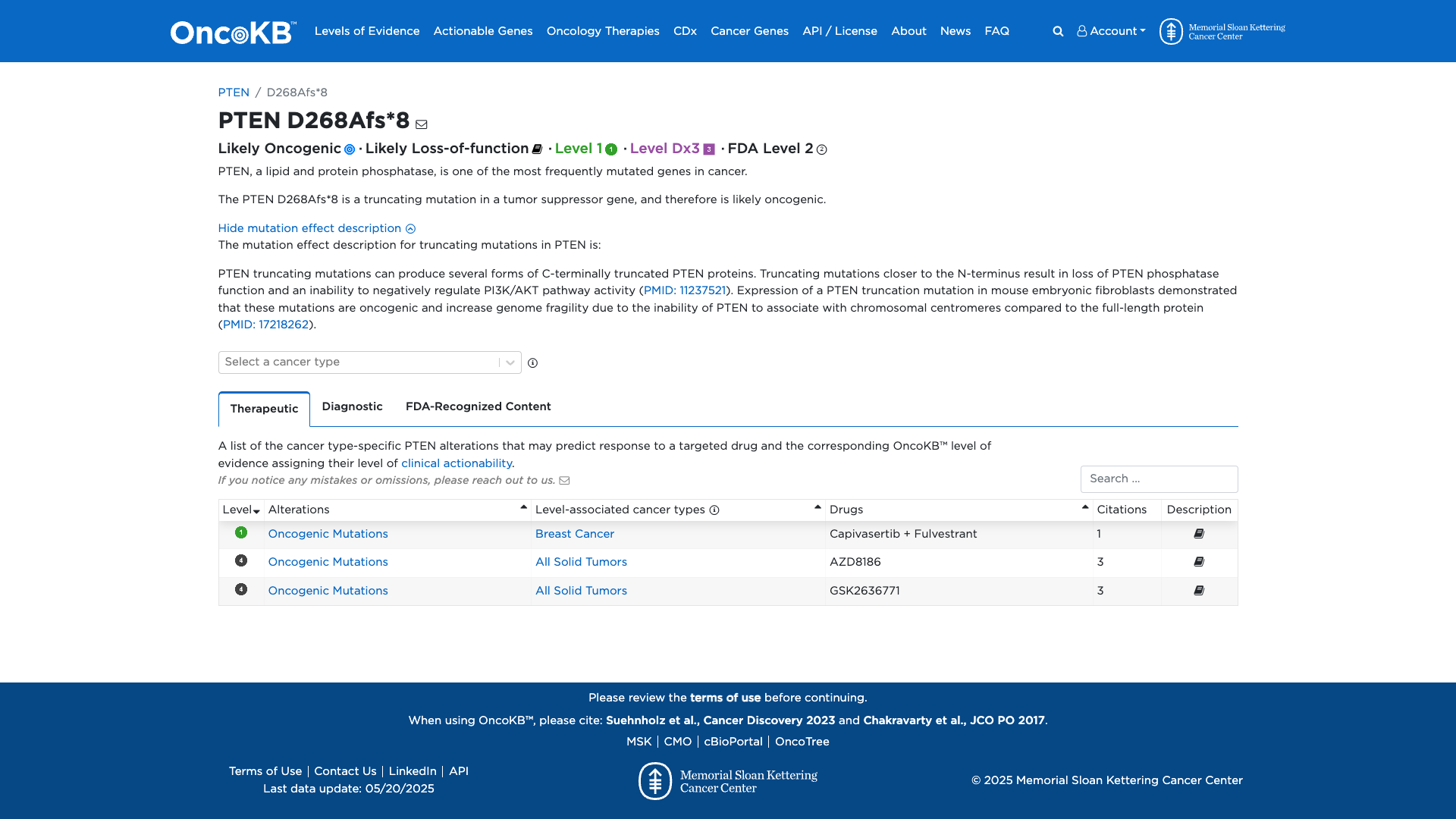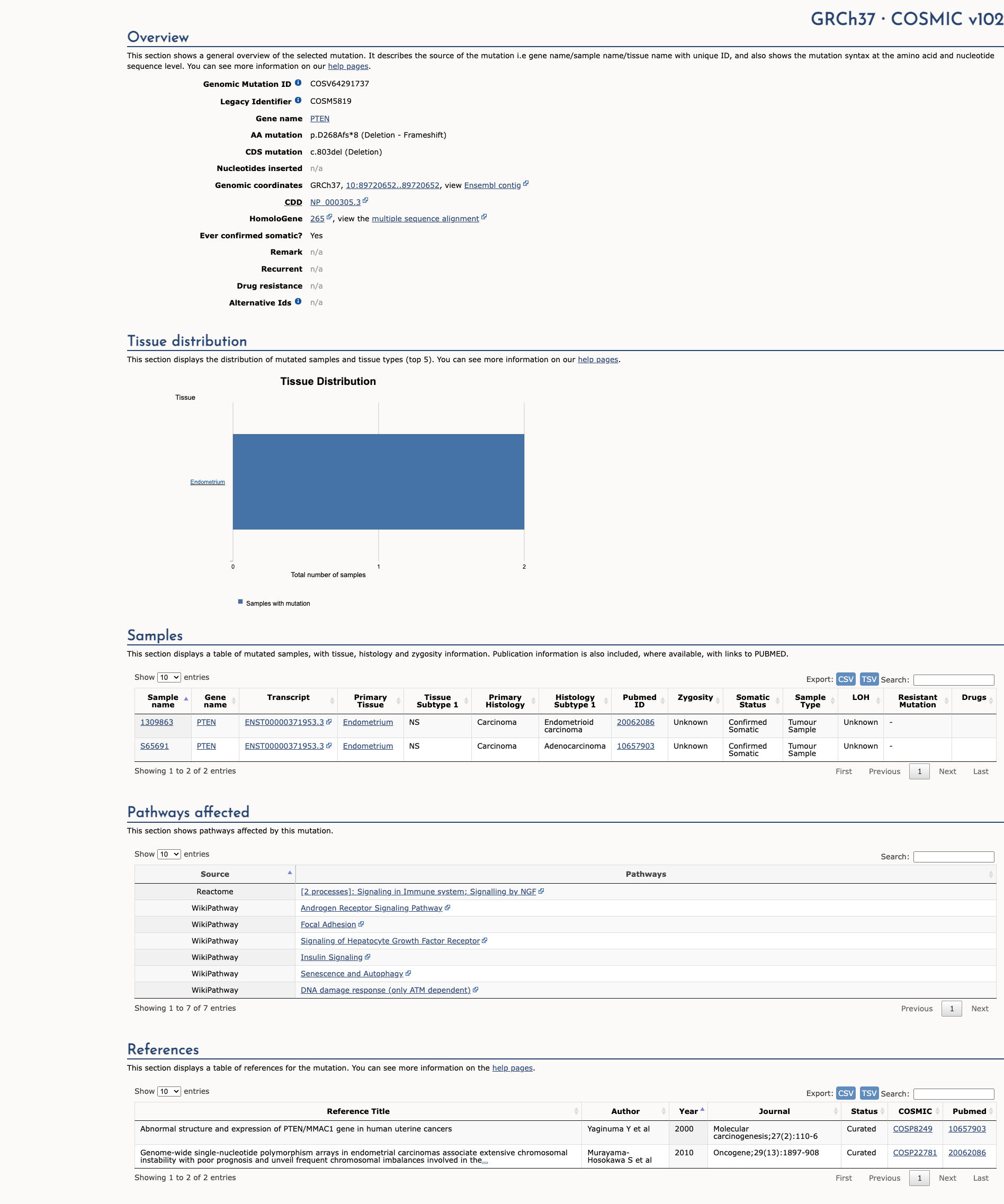PTEN c.803del, p.Asp268AlafsTer8
NM_000314.8:c.803del
COSMIC ID: COSM5819
Pathogenic
The PTEN c.803del (p.D268Afs*8) variant is classified as Pathogenic based on VCEP guidelines, meeting PVS1 (Very Strong), PS3 (Strong), and PM2 (Supporting) criteria.
ACMG/AMP Criteria Applied
PVS1
PS3
PM2
Genetic Information
Gene & Transcript Details
Gene
PTEN
Transcript
NM_000314.8
MANE Select
Total Exons
9
Strand
Forward (+)
Reference Sequence
NC_000010.10
Alternative Transcripts
| ID | Status | Details |
|---|---|---|
| NM_000314.7 | RefSeq Select | 9 exons | Forward |
| NM_000314.5 | Alternative | 9 exons | Forward |
| NM_000314.4 | Alternative | 9 exons | Forward |
| NM_000314.3 | Alternative | 9 exons | Forward |
| NM_000314.6 | Alternative | 9 exons | Forward |
Variant Details
HGVS Notation
NM_000314.8:c.803del
Protein Change
D268Afs*8
Location
Exon 8
(Exon 8 of 9)
5'Exon Structure (9 total)3'
Functional Consequence
Loss of Function
Related Variants
ClinVar reports other pathogenic variants at position 268: D268E
Alternate Identifiers
COSM5819
Variant interpretation based on transcript NM_000314.8
Genome Browser
Loading genome browser...
HGVS InputNM_000314:c.803del
Active Tracks
ConservationRefSeqClinVargnomAD
Navigation tips: Use mouse to drag and zoom. Click on features for details.
Clinical Data
Population Frequency
Global Frequency
0.0 in 100,000
Extremely Rare
Global: 0.0%
0%
0.05%
0.1%
1%
5%
10%+
ACMG Criteria Applied
PM2
This variant is not present in gnomAD (PM2 criteria applies).
Classification
Unknown
Publications (0)
No publication details.
Clinical Statement
Functional Impact
Functional Domain
Hotspot Status
Not a hotspot
Domain Summary
This variant is not located in a mutational hotspot or critical domain (0 mutations).
Related Variants in This Domain
ClinVar reports other pathogenic variants at position 268: D268E
PM5 criterion applied.
Functional Summary
The PTEN D268Afs*8 variant is a truncating mutation that results in the loss of PTEN phosphatase function. Functional studies have shown that such truncating mutations lead to an inability to negatively regulate the PI3K/AKT pathway, contributing to oncogenic activity. Additionally, expression of PTEN truncation mutations in mouse embryonic fibroblasts has demonstrated increased genome fragility due to the loss of PTEN's association with chromosomal centromeres. These findings support a damaging effect of the PTEN D268Afs*8 variant.
Database Previews
OncoKB

JAX-CKB

Click on previews to view full database entries. External databases may require institutional access.
Computational Analysis
Pathogenicity Predictions
Predictor Consensus
Unknown
PP3 Applied
No
VCEP Guidelines
Applied ACMG/AMP Criteria (VCEP Specific) VCEP Guidelines
PVS1
PVS1 (Very Strong)
According to VCEP guidelines: "Very Strong Strength: Very Strong Use PTEN PVS1 decision tree. Modification Type: Disease-specific". The rule for PVS1 is: null variant (nonsense, frameshift, etc.) in a gene where loss-of-function is a known mechanism of disease. The evidence for this variant shows: c.803del is a frameshift predicted to create a premature stop codon (p.D268Afs*8) outside the last exon. Therefore, this criterion is applied at Very Strong strength because it is a truncating loss-of-function variant in PTEN, consistent with the PTEN-specific PVS1 decision tree.
PS1
PS1 (Not Applied) Strength Modified
According to VCEP guidelines: "Strong Strength: Strong Same amino acid change as a previously established pathogenic variant regardless of nucleotide change OR different variant at same nucleotide position as a pathogenic splicing variant, where in silico models predict impact equal to or greater than the known pathogenic variant.". The evidence for this variant shows: it is a frameshift variant, not a missense variant at the same amino acid. Therefore, PS1 is not applied.
PS2
PS2 (Not Applied) Strength Modified
According to VCEP guidelines: "Very Strong Strength: Very Strong Two proven OR four assumed OR one proven + two assumed de novo observations in a patient with the disease and no family history.". The evidence for this variant shows: no de novo data are available. Therefore, PS2 is not applied.
PS3
PS3 (Strong)
According to VCEP guidelines: "Strong Strength: Strong Well-established in vitro or in vivo functional studies supportive of a damaging effect on the gene or gene product.". The PTEN pre-processing finding is: functional assays demonstrate loss of PTEN phosphatase activity and increased genome fragility for the p.D268Afs*8 variant. Therefore, PS3 is applied at Strong strength because well-established studies support a damaging effect on PTEN function.
PS4
PS4 (Not Applied) Strength Modified
According to VCEP guidelines: "Strong Strength: Strong Probands with specificity score 4-15.5 OR the prevalence of the variant in affected individuals is significantly increased compared with the prevalence in controls.". The evidence for this variant shows: no proband case count or prevalence data. Therefore, PS4 is not applied.
PM1
PM1 (Not Applied) Strength Modified
According to VCEP guidelines: "Moderate Strength: Moderate Located in a mutational hot spot and/or critical and well-established functional domain (residues 90-94, 123-130, 166-168).". The evidence for this variant shows: p.D268 falls outside these defined critical domains. Therefore, PM1 is not applied.
PM2
PM2 (Supporting) Strength Modified
According to VCEP guidelines: "Supporting Strength: Supporting Absent in population Databases present at <0.00001 (0.001%) allele frequency in gnomAD or another large sequenced population.". The evidence for this variant shows: it is absent (MAF=0%) from gnomAD. Therefore, PM2 is applied at Supporting strength because the variant is absent from large control databases.
PM3
PM3 (Not Applied) Strength Modified
According to standard ACMG guidelines: "Moderate evidence for recessive disorders: detected in trans with a pathogenic variant.". The evidence for this variant shows: PTEN-associated disease is autosomal dominant, and there is no trans observation. Therefore, PM3 is not applied.
PM4
PM4 (Not Applied) Strength Modified
According to VCEP guidelines: "Moderate Strength: Moderate Protein length changes due to in-frame deletions/insertions in a non-repeat region or stop-loss variants.". The evidence for this variant shows: it is a frameshift, not an in-frame indel or stop-loss. Therefore, PM4 is not applied.
PM5
PM5 (Not Applied) Strength Modified
According to VCEP guidelines: "Moderate Strength: Moderate Missense change at an amino acid residue where a different missense change determined to be pathogenic or likely pathogenic has been seen before.". The evidence for this variant shows: it is a frameshift, not a missense change. Therefore, PM5 is not applied.
PM6
PM6 (Not Applied) Strength Modified
According to VCEP guidelines: "Very Strong Strength: Very Strong Two proven OR four assumed OR one proven + two assumed de novo observations...". The evidence for this variant shows: no assumed or proven de novo data. Therefore, PM6 is not applied.
PP1
PP1 (Not Applied) Strength Modified
According to VCEP guidelines: "Supporting Strength: Supporting Co-segregation with disease in multiple affected family members, with 3 or 4 meioses observed.". The evidence for this variant shows: no segregation data available. Therefore, PP1 is not applied.
PP2
PP2 (Not Applied) Strength Modified
According to standard ACMG guidelines: "Supporting Strength: Supporting Missense variant in a gene that has a low rate of benign missense variation and where missense variants are a common mechanism of disease.". The evidence for this variant shows: it is a frameshift, not a missense. Therefore, PP2 is not applied.
PP3
PP3 (Not Applied) Strength Modified
According to VCEP guidelines: "Supporting Strength: Supporting Multiple lines of computational evidence support a deleterious effect on the gene or gene product.". The evidence for this variant shows: in silico predictions indicate negligible splicing impact (SpliceAI 0.01) and no deleterious computational signal. Therefore, PP3 is not applied.
PP4
PP4 (Not Applied) Strength Modified
According to standard ACMG guidelines: "Supporting Strength: Supporting Phenotype specific for disease with single genetic etiology.". The evidence for this variant shows: no detailed phenotype information is provided. Therefore, PP4 is not applied.
PP5
PP5 (Not Applied) Strength Modified
According to standard ACMG guidelines: "Supporting Strength: Supporting Variant found in a case with an alternate molecular basis for disease.". The evidence for this variant shows: no alternate molecular basis documented. Therefore, PP5 is not applied.
BA1
BA1 (Not Applied) Strength Modified
According to VCEP guidelines: "Stand Alone Strength: Stand Alone gnomAD Filtering allele frequency >0.00056 (0.056%).". The evidence for this variant shows: allele frequency is 0%. Therefore, BA1 is not applied.
BS1
BS1 (Not Applied) Strength Modified
According to VCEP guidelines: "Strong Strength: Strong gnomAD Filtering allele frequency from 0.000043 (0.0043%) up to 0.00056 (0.056%).". The evidence for this variant shows: allele frequency is 0%. Therefore, BS1 is not applied.
BS2
BS2 (Not Applied) Strength Modified
According to VCEP guidelines: "Strong Strength: Strong Observed in the homozygous state in a healthy or PHTS-unaffected individual.". The evidence for this variant shows: no homozygous observations. Therefore, BS2 is not applied.
BS3
BS3 (Not Applied) Strength Modified
According to VCEP guidelines: "Strong Strength: Strong Well-established in vitro or in vivo functional studies shows no damaging effect on protein function.". The evidence for this variant shows: functional studies demonstrate damaging effect. Therefore, BS3 is not applied.
BS4
BS4 (Not Applied) Strength Modified
According to VCEP guidelines: "Strong Strength: Strong Lack of segregation in affected members of two or more families.". The evidence for this variant shows: no segregation data indicating lack of segregation. Therefore, BS4 is not applied.
BP1
BP1 (Not Applied) Strength Modified
According to standard ACMG guidelines: "Supporting Strength: Supporting Missense variant in a gene for which truncating variants are the predominant mechanism.". The evidence for this variant shows: it is a truncating variant itself. Therefore, BP1 is not applied.
BP2
BP2 (Not Applied) Strength Modified
According to VCEP guidelines: "Supporting Strength: Supporting Observed in trans with a pathogenic or likely pathogenic PTEN variant OR at least three observations in cis...". The evidence for this variant shows: no such observations. Therefore, BP2 is not applied.
BP3
BP3 (Not Applied) Strength Modified
According to standard ACMG guidelines: "Supporting Strength: Supporting In-frame deletion(s) in a repetitive region without a known function.". The evidence for this variant shows: it is a frameshift, not an in-frame deletion in a repeat. Therefore, BP3 is not applied.
BP4
BP4 (Not Applied) Strength Modified
According to VCEP guidelines: "Supporting Strength: Supporting Multiple lines of computational evidence suggest no impact on gene or gene product.". The evidence for this variant shows: computational tools predict severe protein truncation; the minimal splicing score does not outweigh the frameshift effect. Therefore, BP4 is not applied.
BP5
BP5 (Not Applied) Strength Modified
According to VCEP guidelines: "Supporting Strength: Supporting Variant found in a case with an alternate molecular basis for disease...". The evidence for this variant shows: no alternate molecular basis reported. Therefore, BP5 is not applied.
BP6
BP6 (Not Applied) Strength Modified
According to standard ACMG guidelines: "Supporting Strength: Supporting Variant reported as benign by a reputable source.". The evidence for this variant shows: no reputable benign report. Therefore, BP6 is not applied.
BP7
BP7 (Not Applied) Strength Modified
According to VCEP guidelines: "Supporting Strength: Supporting A synonymous (silent) or intronic variant at or beyond +7/-21 for which splicing prediction algorithms predict no impact...". The evidence for this variant shows: it is a coding frameshift, not synonymous or deep intronic. Therefore, BP7 is not applied.

